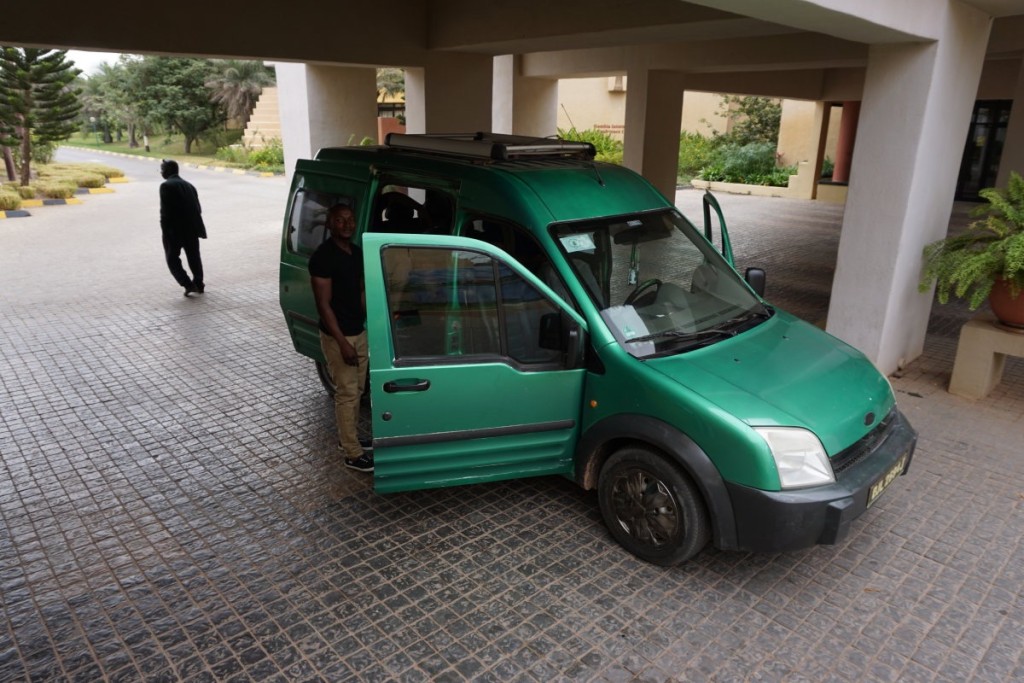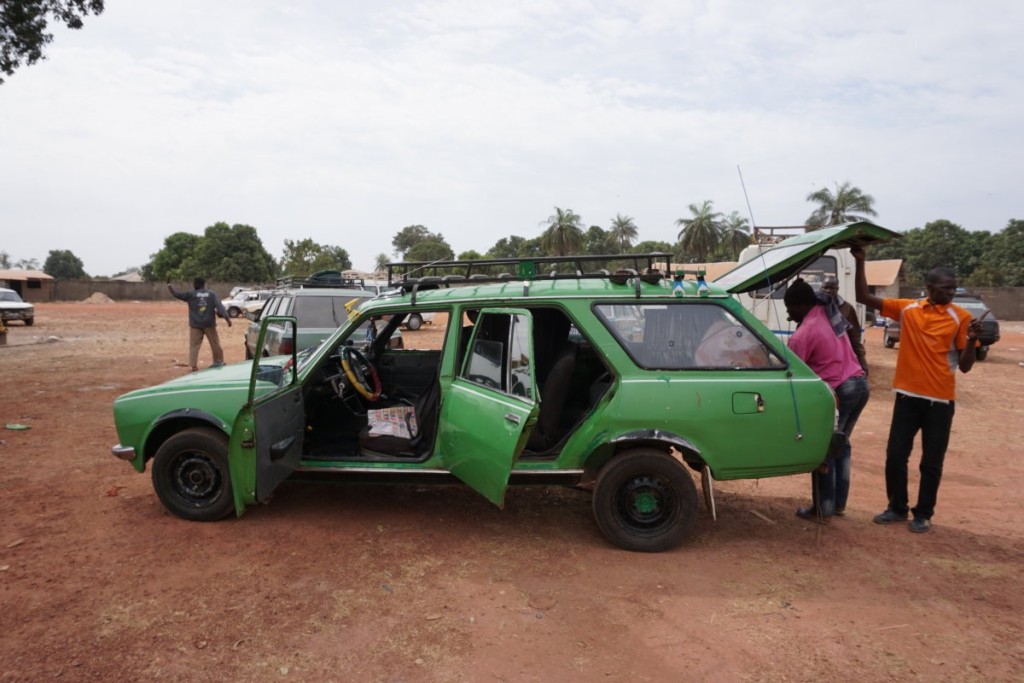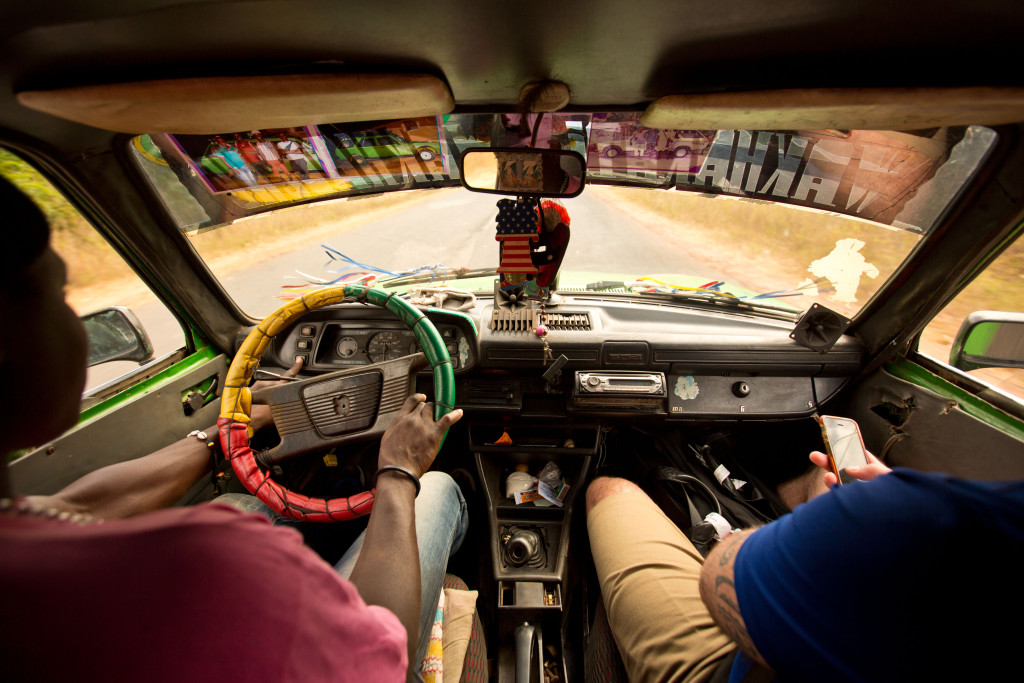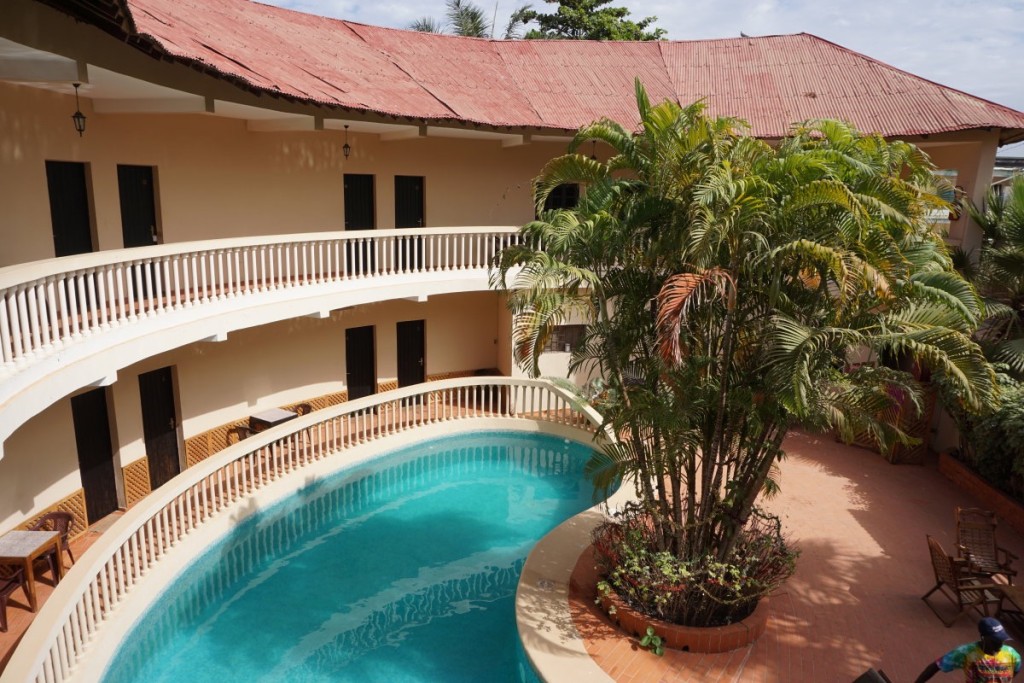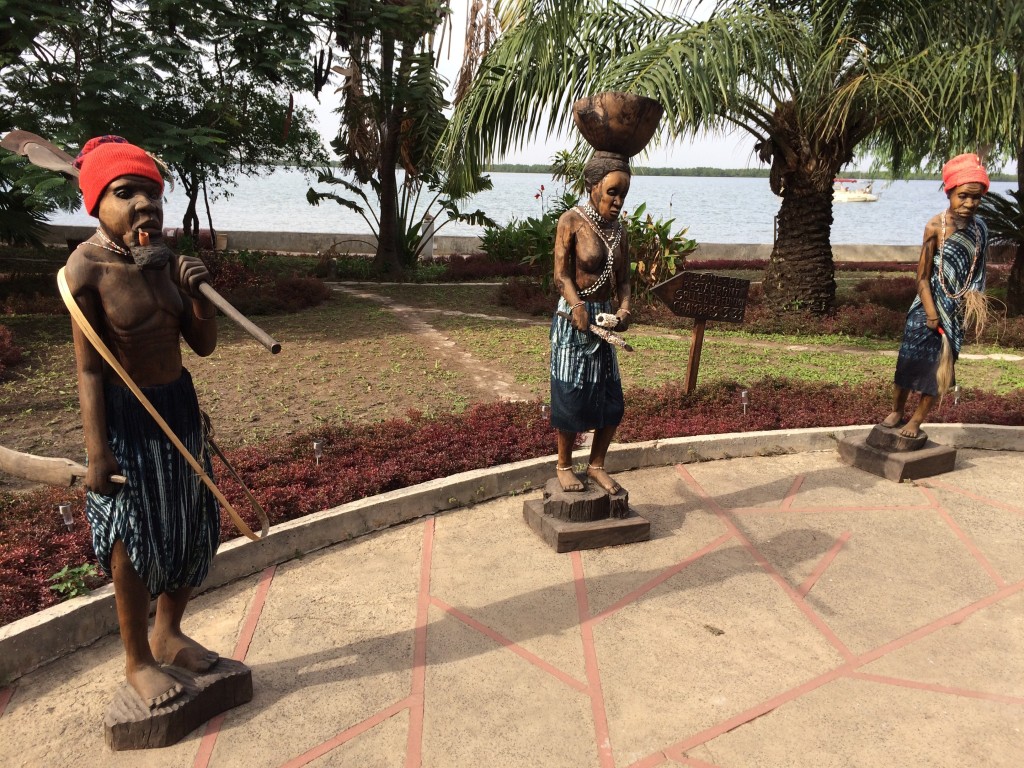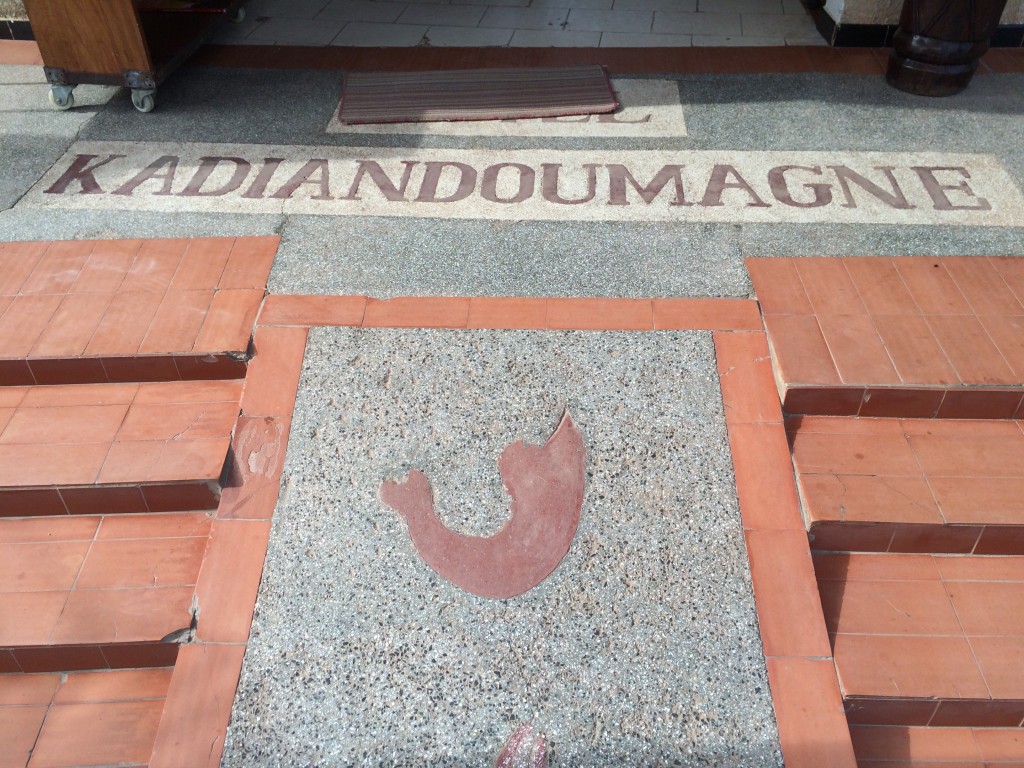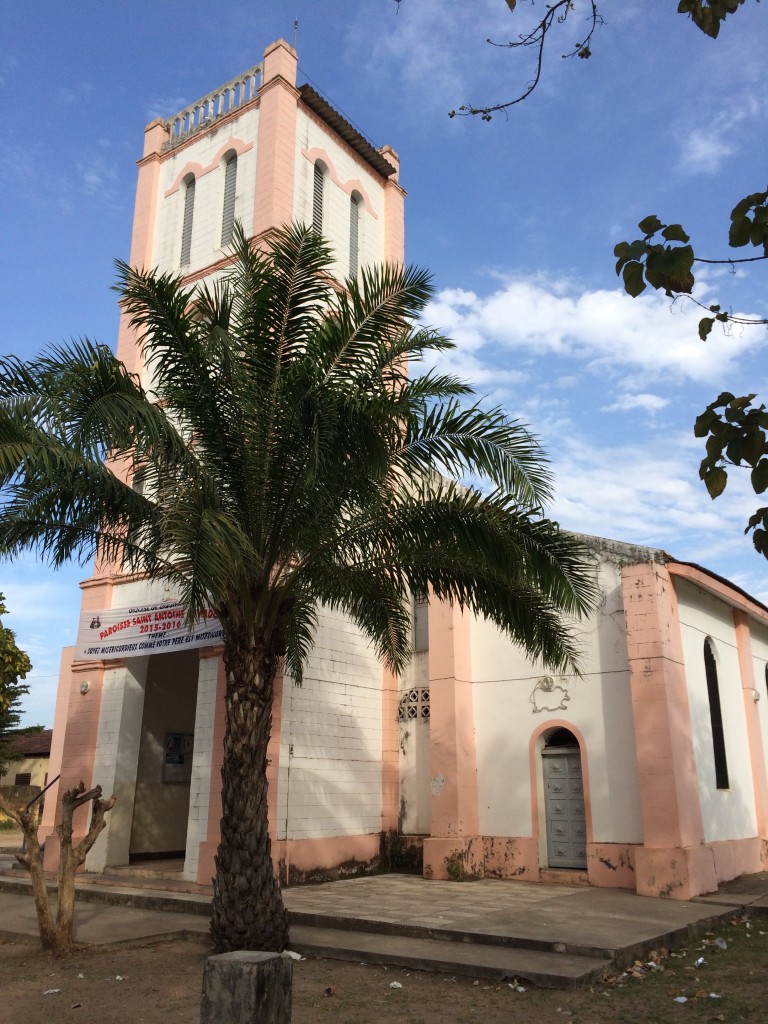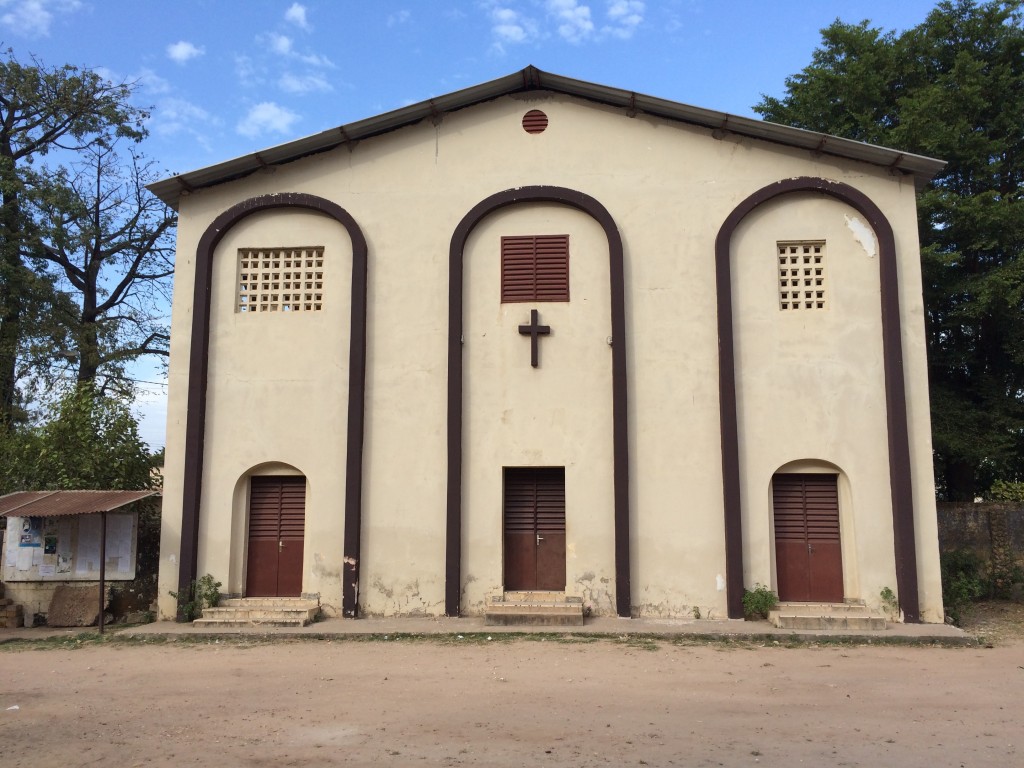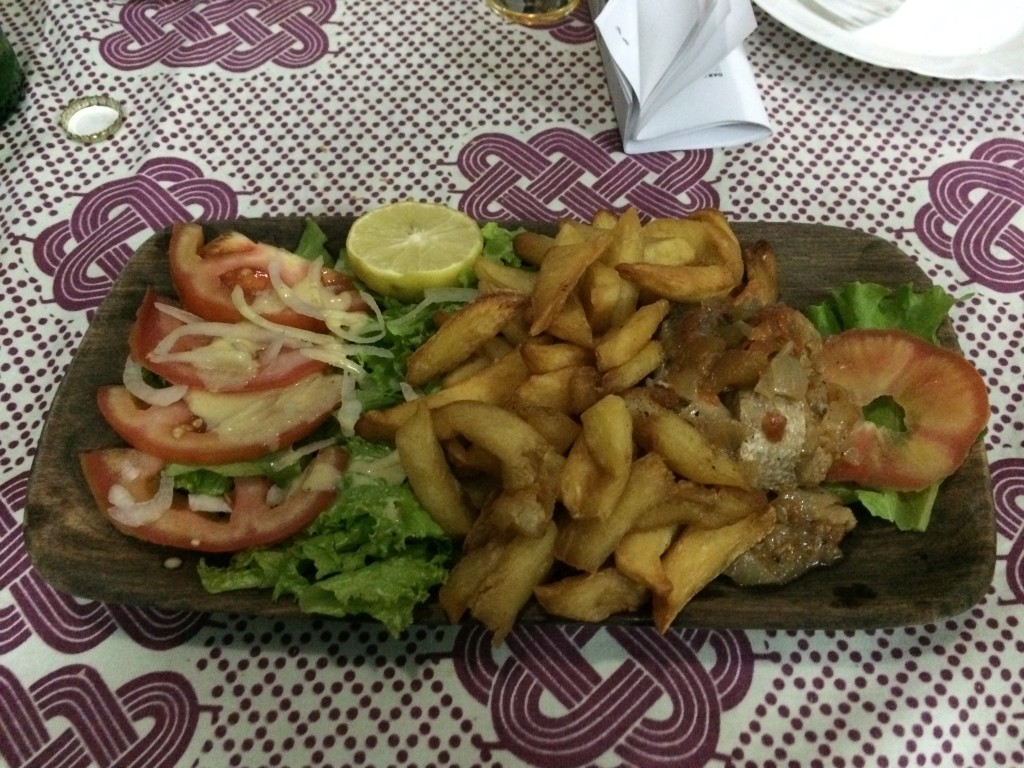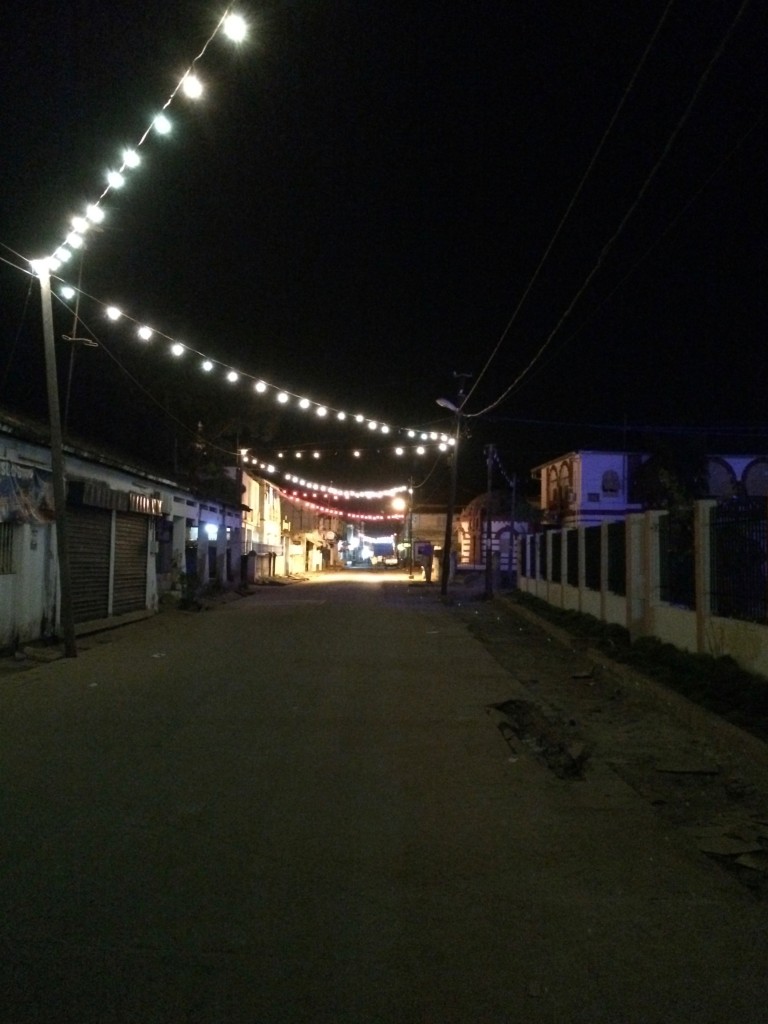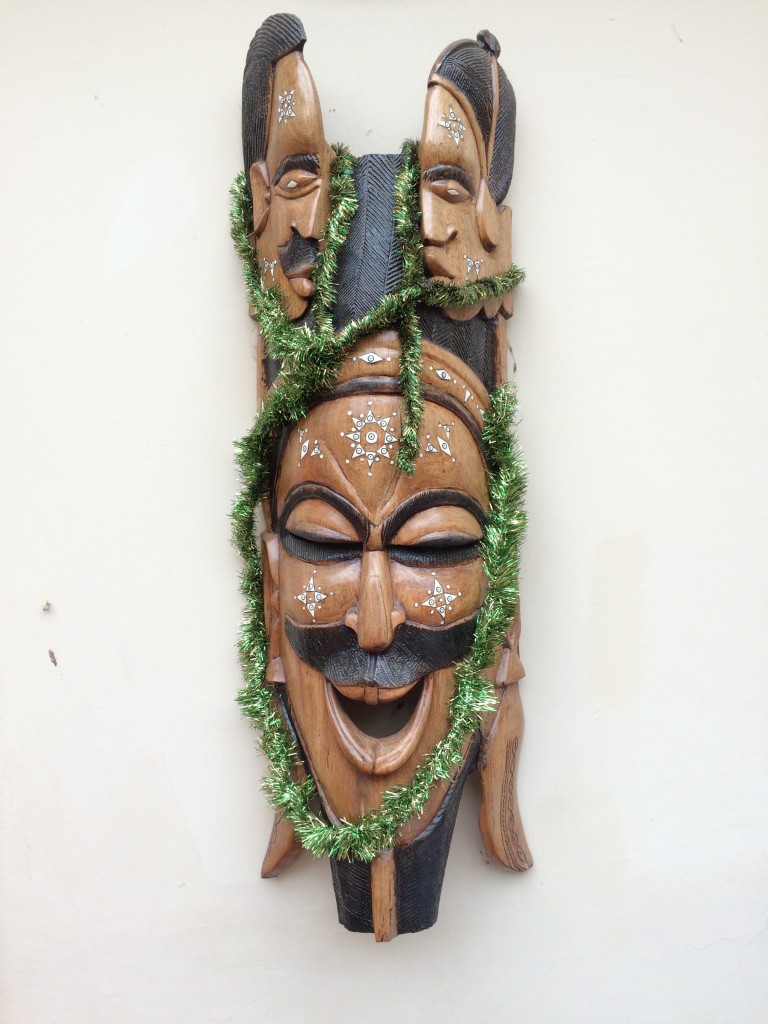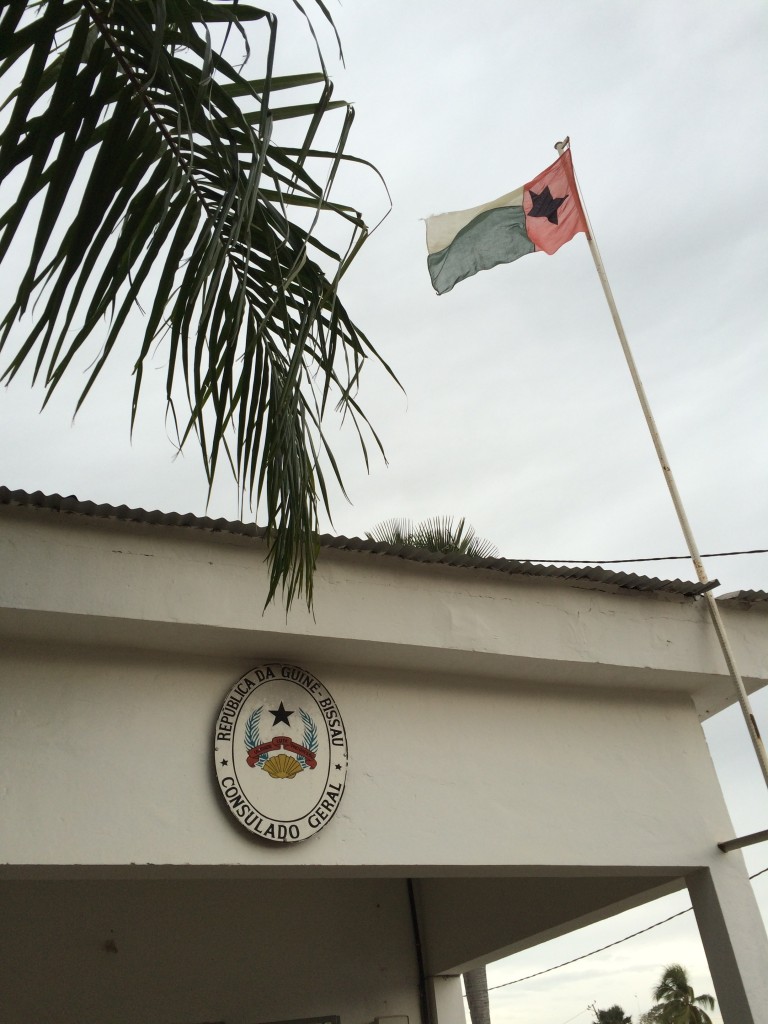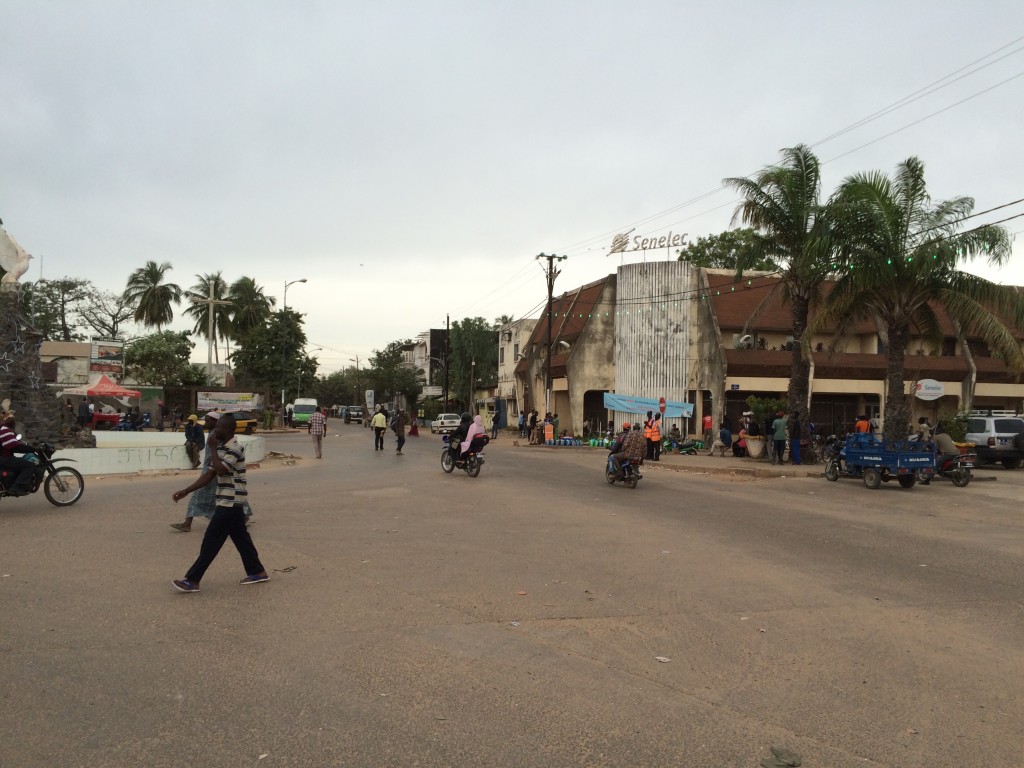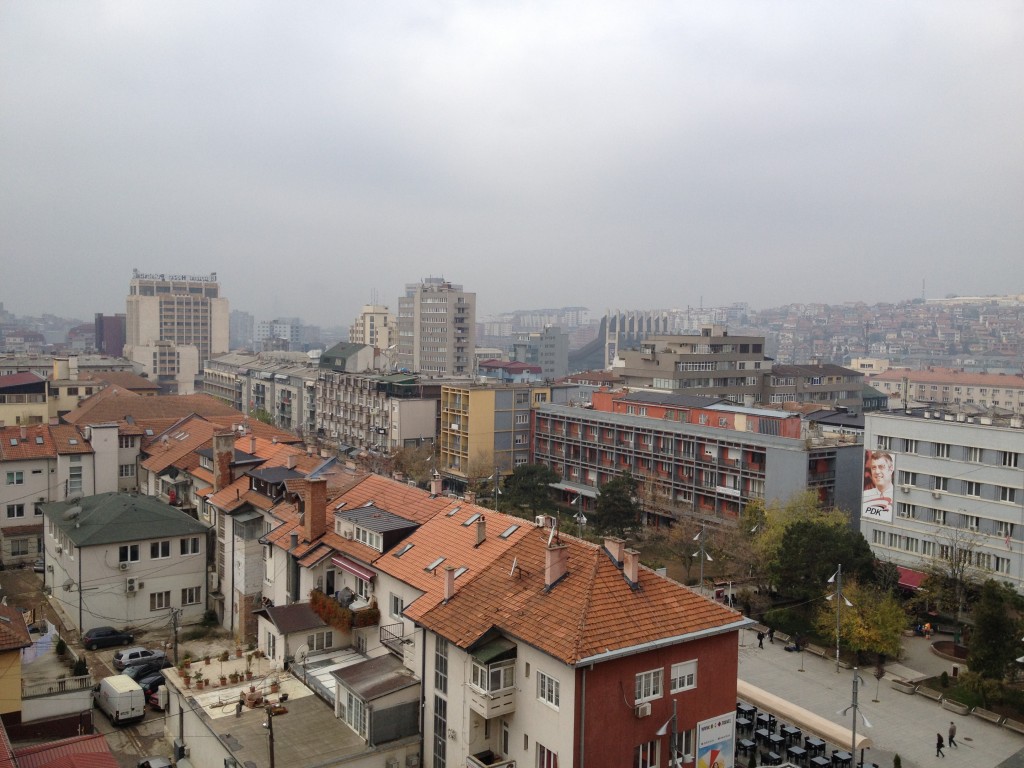Our taxi driver showed up right on schedule, and soon we were off to the Gambia/Senegal border. Our transport to the border, photo courtesy of Jordan:
It looked to be not too long of a drive, and our driver confirmed it should be about an hour, inshallah. Fortunately we had no troubles at all, and got to the border in under an hour. I was expecting some trouble at the border since I’d never been asked to pay for a visa, but nope, super easy and friendly, stamp stamp, and we were out of The Gambia. Our driver was super helpful, and engaged in a bit of negotiation for us.
See, after you get stamped out of The Gambia, you have to drive another two miles to the Senegal entry point/border. However, our driver didn’t have Senegalese/ECOWAS insurance (which we learned was quite common) so he couldn’t take us. He did, however, negotiate a local taxi for us for what came out to be about five US dollars.. Our driver was super helpful, and engaged in a bit of negotiation for us. That driver, however, didn’t want to go all the way to Ziguinchor (the capital of the Senegalese region of Casamance) so we would be going to the local taxi hire and seeing what we could do there.
After dropping us off, he went to find us a “good taxi” – as opposed to a bad one I suppose. This is when all the negotiating started. He had found a good car, but he was going back in what sounded like pretty angry Mandinka with the driver. One spoke French, one spoke English, but they both spoke Mandinka, which left us out in the cold. He told us he had negotiated around 30,000 CFA francs (about US$50) and that sounded good enough, so we agreed. However, when we went to pay him, he wasn’t going to take $5 as agreed because it “took so long.” It was annoying, but only took $1 extra to get him to agree, so it wasn’t so bad.
Once that was done, it was on the road in our rather fabulous ride to Ziguinchor:
Daniel managed to snap this photo from the backseat. Notice the Senegalese flag steering wheel cover, and complete lack of any other dashboard instruments….
The drive itself was pretty uneventful, maybe two hours or so, and we arrived in Ziguinchor. Our driver had a bit of a hard time finding the hotel, so he headed first to the taxi station to check in. He needed to go there to get in the queue to go back to Banjul for his next trip, so wanted to make sure to check in before dropping us off. He also used this to get directions to our hotel, which wasn’t too far away.
We arrived at the Le Flamboyant Hotel, where the friendly staff let us know our rooms were ready. They were rather basic, but for less than US$40 per night they were amazing. Good, functional air conditioning as well as good free WiFi and breakfast for like $4. Can’t really go wrong at all! The bed was pretty hard, but given I slept nearly nine hours it must have been pretty comfortable!
View from the balconies:
After checking in, we were pretty hungry so went for a walk through town to find some lunch. We eventually managed to stumble upon the Kadiandoumagne Hotel, which was serving up lunch still…and had great carvings in the courtyard:
The lunch special, strangely, was Cordon Bleu…served with either beef or ham. I went with the beef option, and it was rather tasty all things considered. Washed down with a La Gazelle beer it was tasty enough, and fueled me for what was to be an afternoon wander.
Next stop was the local church/cathedral. Unlike most of Senegal, Casamance is largely Christian and animist, which fueled a decades long struggle for independence from Dakar which only ended a few years ago. No signs of conflict here, however, although the church has clearly seen better days:
We wandered the town for maybe an hour, where I eventually came upon a Total station which had ice cold Diet Coke. It was a message from the gods! I made mental note of it, so I could stop by the next day for snacks before we headed onwards to Guinea-Bissau.
After resting in the hotel a bit, we headed out for dinner at the Le Parroquet hotel and restaurant. Fresh-caught Barracuda was the special, but very small pieces buried under a large pile of chips and salad. At least it was pretty tasty, and they had bananas flambé as the dessert!
After a relaxing dinner, we headed back through the “well-lit” centre of town to the hotel. Yes, this is bustling Ziguinchor, Casamance, Senegal:
When I got back to the hotel, they informed me they hadn’t fumigated the room for mosquitos since I didn’t leave my key. I agreed to stay out of the room for 15 minutes, and they went in and absolutely sprayed the hell out of things. I went to dreams with foggy memories of dead bugs, and slept like a rock on the rock-solid bed. Up for breakfast in the courtyard: instant coffee, baguette, and some bissap juice was the order of the day. Daniel tried to get some eggs, but apparently the chickens weren’t around because they told him they didn’t have them today. But what they did have was a very festively decorated African mask hanging in the courtyard:
After breakfast, our mission was to find the consulate of Guinea-Bissau and get a visa. Why hadn’t I done this in Washington, you ask? Well, Guinea-Bissau is one of like two or three countries that doesn’t have a capital in DC. The others are tiny countries like Tuvalu, but Guinea-Bissau…that’s a unique case. See, they used to have an embassy in the suburbs in Maryland, but somewhere around 10 years ago they ran out of money…and rumour is the bank foreclosed on the mortgage. That’s right…the Bank repossessed the embassy. Even stranger, because you’d think under diplomatic conventions they should be protected against this or something, but whatever the true story, there is no longer an embassy in DC and the consulate in New York doesn’t issue visas.
Since so many people go overland from Banjul to Bissau, general consensus is that Ziguinchor is the best place to get a visa. The embassy had moved a couple years ago because, well, they couldn’t afford the rest on the main street in Ziguinchor, but after a good wander through a residential area with dirt roads, we finally found it:
There, the consul was very cheery and helpful, and we joined several others getting a visa…all Americans oddly enough. A group of older American women who’d been in The Gambia and decided why not see Bissau while they were in the area (seriously – my heroes!) and a strange evangelical guy from Texas who was going to Bissau to do some sort of missionary work. That said, the consul was great, we had visas in like 20 minutes, and they were dirt cheap at 20,000 CFA francs (around $33) versus the 55,000 francs charged in Dakar!
Walking back to the hotel, I stopped at the Total station again to get some biscuits and Red Bull for the journey (one small packet of instant coffee was not about to cut it) and then we went to pack up. View of the main circle in town from the Total Station:
After the walk, it was time to get some extra cash just in case the ATMs in Bissau weren’t functional as rumoured online. The first ATM I tried in Ziguinchor was out of service, and then when walking the half mile or so to the next it started raining. Which didn’t matter, because it didn’t want to take my card either. Neither did the third ATM.
Nearly a mile of walking later, we found a fourth ATM, and it started to make very promising noises…which I discovered were the sound of “I’m going to digest and keep your card now…mkay?” Panic ensued…almost. Here I was in relatively rural Africa, low on cash, and no ATM card to improve the situation. Oh, and it was raining and I was seriously soaked. Miracle of miracles, the bank branch was actually open….but when I got inside there were over 100 people waiting to see a teller/agent. I pulled the stupid/crazy/confused white guy, and just walked right to the front of the line and told her the machine ate my card.
Apparently, this is not uncommon. She signed, and asked for my passport. I told her I didn’t have it. She sighed. I offered to write down everything about the card on a piece of paper…she sighed and went in the back. Miraculously, she came back with my card, looked to see that it somewhat matched what I’d written down, and gave it to me. Whew. Huge disaster averted.
With that, it was back to the hotel to pack up and get ready to head to country #187 visited – Guinea-Bissau!
